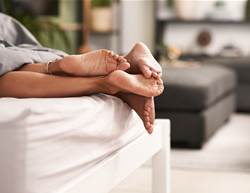Last time you let out a hearty laugh or cough, did a little pee escape too? It happens to the best of us, and it’s one common sign that your pelvic floor could use a little TLC.
“The pelvic floor is a group of layered muscles that line the bottom of the pelvis like a hammock. They support the bladder, uterus, and rectum; prevent incontinence; aid in sexual function; contribute to core stability; and provide circulatory support for the lymphatic system,” explains Alexia Harrigan, pelvic health physical therapist.
Your pelvic floor naturally weakens with age, and certain lifestyle factors such as high-impact exercise (eg running, jumping, or lifting weights), childbirth, and injury can also compromise it. Having trouble orgasming or feeling as if you have to pee or poop when you really don’t are other signals that those pelvic muscles may be lax, says fitness instructor Rachel Nicks.
Thankfully, you can shore up your pelvic floor so you can continue to thrive without mishaps. Here, pelvic floor experts give you one task to tackle at a time. The end goal: make these part of your day-to-day routine.
Pelvic Floor Exercises to Try at Home
Step 1: Master Kegels
These exercises target the pelvic floor muscles and are an important piece of the strengthening puzzle. Once you know how to do Kegels properly, aim to do them daily.
- Find the right muscles: Insert a clean finger into your vagina and clench so you feel the muscles closing around it.
- Now work them! You can stand, sit, or lie down for this. Clench the muscles and hold for 3 seconds; relax for 3 seconds. Repeat 5 to 10 times, and aim to do at least 30 each day.
Step 2: Tweak your habits
Simple changes to everyday actions make for a sturdier pelvic region. Try to hit all of these this week so you can turn them into new habits: Breathe while running, jumping, and lifting weights. “This helps decrease buildup of internal pressure that could further burden your pelvic floor,” says Harrigan.
- Try not to strain too much while pooing. Don’t push while urinating, and don’t hover over the toilet.
- When you feel a sneeze or a cough coming on, engage your pelvic floor muscles until you’re done. This way “pressure exits via the mouth and nose instead of going to the pelvic floor,” Nicks says. Also do this before jumping or lifting any type of weight.
- Relax rather than tensing up when masturbating or having sex to help prevent discomfort.
- Learn to zap stress. “The pelvic floor is hardwired to the autonomic nervous system, so lowering stress is vital,” Harrigan says.
Step 3: Work out pelvic-adjacent muscles
The pelvic floor is part of a system (including the core, hips, and back), and all of it must function well for optimal pelvic health. These moves are two exercises that strengthen the pelvic floor—squeeze them in three to four times a week:
- Bird Dog: Start on all fours. Look at the ground and engage your abs. Reach one arm out in front of you while extending the opposite leg behind you so your body forms a straight line. Repeat with the other arm and leg. Do 15 to 20 on each side.
- Single-Leg Bridge: Lie down with one leg bent at the knee and the other extended straight. Lift your hips and the extended leg while pressing the foot of your bent leg into the floor. Squeeze your glutes, then lower. Do this 15 to 20 times.









